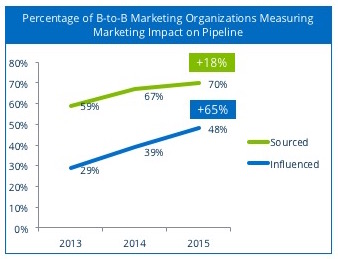Marketing Pipeline Metrics: Restoring Balance
- Marketing sourced pipeline is a common but incomplete way to demonstrate marketing’s contribution
- Measuring marketing’s influence is a reliable way to show that marketing is making a difference
- Influence measurement loses credibility when not linked to business value – but this is correctable
Marketing sourced pipeline is one of the most commonly reported performance metrics for B2B marketing (70 percent of organizations in our benchmark consistently report on it). Modern B2B marketers point to this metric with pride, because it serves as a sign of accountability and proclaims, “We, as marketers, take our role in our company’s revenue creation process seriously!”
But some companies are relying too heavily on marketing sourced pipeline in their measurement system. If you’re placing a singular focus on sourced pipeline, you’re likely doing harm, as focusing too narrowly in an attempt to demonstrate real accountability can encourage the company and leadership to lose sight of how marketing is really expected to create value.
Some B2B marketing organizations source more than 50 percent of their company’s pipeline. If you’re doing that, congratulations! But most B2B marketing organizations do not, cannot, will not and should not source such a large portion of their company’s pipeline. Companies marketing to a defined universe of potential buyers or those with a focus on strategic accounts, a well-established client base, or a focus on upsell revenues are examples of companies where marketing sourced pipeline numbers will be lower. In these situations, these numbers can fall between 5 percent and 20 percent of the overall pipeline number. When this is the case, the role of marketing becomes different, and measurement should be different, too.

Follow the Money
If marketing intends to demonstrate accountability, you’ll need to show performance against what marketing invests in. To get your arms around this, look at where marketing program dollars are being spent. If your organization spends significantly on sales enablement, pipeline acceleration or renewal efforts, measuring marketing sourced pipeline is an incomplete way to demonstrate achievement.
Instead, look at big areas of investment and ask what they’re expected to achieve. Commonly, marketing is expected to help sales close pipeline faster, succeed in more deal cycles, and drive client relationships and revenue. But sales has a role in this, too. And some marketing leaders – cautious about asserting too much credit for metrics they don’t own singularly – retreat into sourcing metrics. That’s a mistake – it leaves marketing investment uncovered by metrics that can show marketing impact.
The Right Way to Measure
Demonstrating the impact of marketing when performance is the result of cross-functional efforts requires three elements:
- Show performance of shared impact metrics. Whether the goal is increased deal velocity, better renewal rates or improved customer loyalty, you need to demonstrate that the impact metrics marketing invests in are, in fact, improving.
- Provide proof of marketing participation. You need to prove that when marketing tactics are accepted by target audiences, impact metrics improve. If marketing isn’t involved, it will be uncomfortably difficult to assert any type of marketing influence over that performance improvement.
- Present evidence that performance metrics change as marketing participation changes. Evidence of marketing impact requires a comparison. Some deal cycles may have light levels of marketing interaction, some may have heavy levels, and some may have no marketing interaction at all. When you compare what improvements take place when marketing is present to what happens when marketing is not, you can develop reasonable proof that marketing is making a difference.
The latter type of metric is commonly referred to as measuring marketing influence. Organizations new to measuring marketing influence typically begin by measuring what portion of pipeline marketing has interacted with. The number of companies doing this has been trending up in recent years (up 65 percent since 2013), but only 48 percent of B2B marketing organizations regularly measure marketing influenced pipeline. The other 52 percent of organizations likely have a gap in their measurement approach and the way they prove marketing’s value. And when value isn’t proven, marketing resources understandably come under fire.
The good news is that even if your company isn’t incorporating influence into its measurement system, it’s not too late to start.
